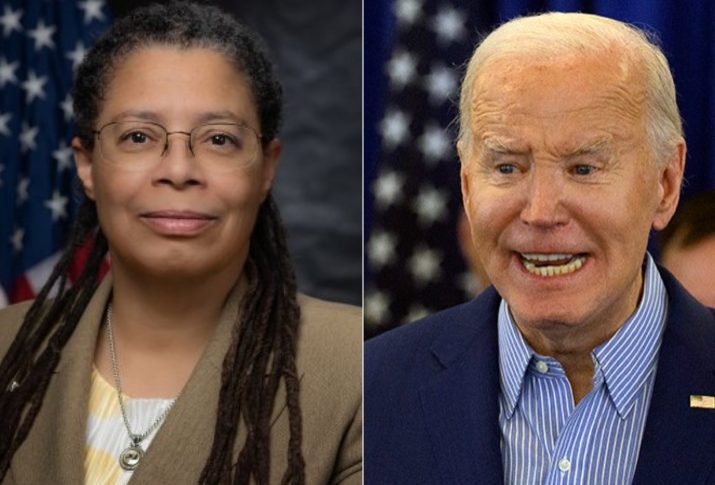The Biden Admin Forced Gas and Coal Plants To Embrace Carbon Capture—Then Privately Told Climate Activists To Fight It

Last April, the Biden administration finalized environmental rules that effectively force gas and coal plants to adopt carbon capture—an expensive and controversial process in which emissions are stored underground—or risk shutting down. Months later, in November, a senior Biden EPA official told activists to “keep fighting” an ExxonMobil carbon capture project in Texas, the Washington Free Beacon has learned.
The comments were made by Earthea Nance, who leads the EPA’s Region 6 office, at a meeting held on Nov. 18 in Jefferson County, Texas, according to contemporaneous notes from a meeting attendee reviewed by the Free Beacon. And they came in response to environmentalists’ protests regarding ExxonMobil’s proposed Rose Carbon Capture and Storage Project, which the EPA is tasked with permitting.
Nance’s comments are significant because the Biden administration forced gas and coal plants to embrace carbon capture in order to lower their overall emissions to acceptable levels under the EPA’s strict regulations—and companies who don’t comply with the regulations face hefty fines. According to the EPA, carbon capture and storage is a “key part” of the Biden-Harris administration’s goal to reach a net-zero emissions economy by 2050 and Congress earmarked hundreds of millions of dollars to the EPA and Department of Energy to support such projects.
Carbon capture and storage technology traps the carbon emissions from an industrial source such as a power plant, then transports those gases via pipeline to a site where they are injected deep in a subterranean rock formation. The technology, while not yet deployed at scale in the United States, has been touted as a bipartisan climate solution, but has received pushback from environmentalists concerned with the impacts it may have on groundwater.
“I’m disappointed, but certainly not surprised,” Tom Pyle, the president of the Institute for Energy Research, told the Free Beacon. “The Biden administration touts these technologies and uses them to justify their rulemakings that make it harder to use fossil fuels, but then they undermine the very technologies they’re promoting because, in reality, they would prefer they not be utilized at all.”
“They have also slow-walked nearly all of the permitting applications for these projects as well,” Pyle added. “So, on the one hand, they tout ‘carbon reduction’ solutions for the industry, but on the other hand, their objective, as evidenced by Dr. Nance, its to put the oil and gas industry out of business.”
While the meeting—which Nance attended alongside EPA attorney Jay Przyborski, EPA environmental justice executive director Eunice Varughese, and three members of the EPA’s emergency response underground injection control team—was intended to address a broad set of issues related to the local community, participants mainly focused on ExxonMobil’s Rose project.
“What is an acceptable amount of death for you all to allow this ExxonMobil application to pass?” one attendee asked the EPA officials at the November meeting in Texas. “Exxon feels like they can just come in and do what they want because they’ve spent a lot of money,” another participant said. A third participant added, “we’re paying for Exxon to kill us,” noting the tax benefits ExxonMobil is leveraging to fund the project.
In response, Nance encouraged the activists to “keep fighting” and advised them to “document the stress the community is feeling, document property value changes, start gathering evidence.” Later in the meeting, Nance expressed her own frustration that there were loopholes in the EPA’s permitting process for carbon capture and stated that she had her own questions about the agency’s authority on the matter.
Nance’s concerns could explain the myriad delays with the EPA’s permitting for carbon capture projects since energy companies started aggressively investing in the technology in recent years. According to the EPA’s internal data reviewed by the Free Beacon, the agency has only issued eight final permit decisions on carbon capture projects and is reviewing 163 applications.
The data show that projects regularly face years of permitting, a process that almost always stretches past the EPA’s goal of permitting projects within 24 months. For example, the oldest project under review, the so-called CTV Elk Hills project in Kern County, California, was first submitted by its developer in August 2021, but received its permits this month and is not projected to receive a final federal approval until August 2025.
ExxonMobil’s Rose project was first proposed in early 2024 and is slated to receive a final permit decision in April 2026. The company projects that, if approved, it would lead to more than $7 million in economic output, create more than 300 construction jobs, and generate more than $700,000 in tax revenue.
During his confirmation hearing Thursday, President-elect Donald Trump’s pick to lead the EPA, former Rep. Lee Zeldin (R., N.Y.), vowed to speed up permitting for carbon capture projects, signaling a departure from the current administration’s policy. He added that, if confirmed, he would ensure the EPA does not lengthen environmental permitting to hold up projects that “otherwise would be and should be approved.”
ExxonMobil did not respond to a request for comment.
The EPA did not dispute that Nance made the comments attributed to her. EPA Region 6 spokesman Joseph Robledo said Nance “continues to support President’s Biden commitment to carbon capture technologies with standards that protect local communities and the environment. During Dr. Nance’s first year as Regional Administrator, she helped shape EPA’s national Carbon Capture, Utilization and Storage Policy. More recently, under Dr. Nance’s leadership, EPA Region 6 proposed draft Class VI permits to Oxy Low Carbon Ventures LLC. EPA Region 6 is actively reviewing additional Class VI permits.”




